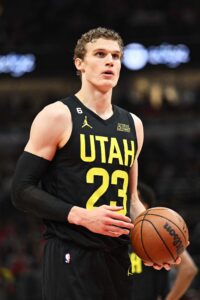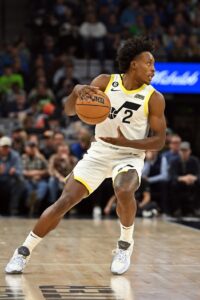The Jazz were supposed to bottom out in 2022/23.
They’d just traded away nearly their entire starting lineup, including All-Stars Rudy Gobert and Donovan Mitchell and forwards Bojan Bogdanovic and Royce O’Neale. Those roster moves – and the fact that several other veterans were still on the trade block – suggested that CEO Danny Ainge, general manager Justin Zanik, and the rest of the front office were all-in on the Victor Wembanyama sweepstakes.
Then the season started and Utah looked more like a powerhouse than a bottom-feeder. The Jazz won 10 of their first 13 games out of the gate and held the No. 1 spot in the Western Conference over a month into the regular season.
Utah eventually slid down the standings, as expected, but the team easily exceeded preseason expectations by winning 37 games, even after trading away starting point guard Mike Conley and other key rotation players during the season.
When the Jazz dealt Gobert and Mitchell during the 2022 offseason, the focus was on the draft assets they received, since the packages they got for their two stars were heavy on unprotected future first-rounders.
 But it was Lauri Markkanen (acquired in the Mitchell deal) and Walker Kessler (part of the Gobert package) who paid big early dividends for the franchise. Markkanen earned his first All-Star berth and was named the NBA’s Most Improved Player, while Kessler finished third in Rookie of the Year voting and was fourth in the league in blocks per game (2.3) despite averaging only 23.0 MPG.
But it was Lauri Markkanen (acquired in the Mitchell deal) and Walker Kessler (part of the Gobert package) who paid big early dividends for the franchise. Markkanen earned his first All-Star berth and was named the NBA’s Most Improved Player, while Kessler finished third in Rookie of the Year voting and was fourth in the league in blocks per game (2.3) despite averaging only 23.0 MPG.
With Markkanen and Kessler under contract for multiple seasons, the Jazz have two intriguing cornerstones to build around and an opportunity to accelerate their rebuild even if they don’t have any luck in the 2023 draft lottery.
The Jazz’s Offseason Plan:
The Jazz are ninth in the lottery standings, so their odds of landing a top-three pick aren’t great (14.5%). That’s not the end of the world though. While Utah would obviously love to add one of 2023’s top prospects to its current core, the team is well positioned to continue adding talent even if that pick stays at No. 9.
For one, that lottery selection is just one of three first-rounders the Jazz own this June. They also control the Timberwolves’ pick at No. 16 and the Sixers’ at No. 28, putting them in position to either add a handful of rookies to the roster or to turn one or two of those picks into a trade asset.
The Jazz will also enter the offseason with the ability to generate significant cap space. Their guaranteed salary total of $47.6MM is a little misleading, since there could be as many as four player options to account for, along with some non-guaranteed salaries and cap holds for draft picks. But if we assume Talen Horton-Tucker, Rudy Gay, and Damian Jones all opt in, Kelly Olynyk and Kris Dunn are retained, and Utah keeps all three of its first-rounders, there could still be in excess of $42MM in cap room.
The big question will be at what pace the Jazz want to proceed as they build their roster. Ainge and Zanik are smart enough to recognize that just because the team won 37 games in 2022/23, that doesn’t mean that number will continue to rise as long as the front office makes an upgrade or two to the roster. Growth isn’t necessarily linear and a similar group could just as easily take a step back next season.
In theory, Utah is in a strong position to use its projected cap room to sign one impact player and to package its trade assets (including five future unprotected first-round picks from Minnesota and Cleveland) for a second impact player.
But after going into sell mode last offseason, I don’t expect the Jazz to do a 180 and essentially pull off the inverse of those Gobert and Mitchell trades this summer. The club seems more likely to exercise patience in building its new-look roster, despite last season’s success.
That means Utah’s cap room might be best used to accommodate salary dumps. With a more punitive new CBA taking effect in 2023/24, there will be teams around the NBA looking to move off unwanted money. The Jazz could capitalize on their cap flexibility by lessening the financial burden for one or two of those teams and acquire more draft picks in the process.
Assuming the front office takes the long view, I wouldn’t be surprised to see them trade one of their three 2023 first-rounders for a pick or two in a future year. That would allow the Jazz to continue building up their collection of future draft assets and to avoid bringing three first-round picks to camp this fall.
The team will also have to decide whether or not Jordan Clarkson is in its long-term plans. A Sixth Man of the Year winner during his time in Utah, Clarkson has proven to be an effective scorer for the Jazz and was a good value on his four-year, $52MM contract, but will likely turn down his $14.3MM player option in search of a more lucrative deal.
The Jazz have the financial flexibility necessary to accommodate Clarkson, but re-signing him could cut their cap room nearly in half, and Ainge has spent the last year moving off virtually every other veteran on the roster — perhaps Clarkson will be next.
The 2022/23 season showed that the Jazz probably won’t need to spend several years mired in a long rebuilding process, but they’re not on a fast-track to contention yet. The next steps are crucial and will help determine just how quickly Utah can move past its roster teardown and reclaim its place as an annual playoff team in the West.
Salary Cap Situation
Guaranteed Salary
 Collin Sexton ($17,325,000)
Collin Sexton ($17,325,000)- Lauri Markkanen ($17,259,999)
- Ochai Agbaji ($4,114,200)
- Simone Fontecchio ($3,044,872)
- Kelly Olynyk ($3,000,000)
- Note: Partial guarantee. Rest of salary noted below.
- Walker Kessler ($2,831,160)
- Micah Potter (two-way)
- Total: $47,575,231
Dead/Retained Salary
- None
Player Options
- Jordan Clarkson ($14,260,000): Bird rights
- Talen Horton-Tucker ($11,020,000): Bird rights
- Rudy Gay ($6,479,000): Early Bird rights
- Damian Jones ($2,586,665): Non-Bird rights
- Total: $34,345,665
Team Options
- None
Non-Guaranteed Salary
- Kelly Olynyk ($9,195,122)
- Note: Partial guarantee. Olynyk’s salary would become fully guaranteed if he’s not waived on or before June 28.
- Kris Dunn ($2,586,665)
- Note: Dunn’s salary would become fully guaranteed if he’s not waived on or before October 23.
- Luka Samanic ($2,066,585)
- Note: Samanic would receive a partial guarantee ($400K) if he’s not waived on or before July 18. That partial guarantee would increase to $600K if he’s not waived on or before October 23.
- Vernon Carey Jr. ($1,997,238)
- Note: Carey’s salary would become fully guaranteed if he’s not waived on or before October 23.
- Total: $15,845,610
Restricted Free Agents
- None
Two-Way Free Agents
Draft Picks
- No. 9 overall ($5,487,120)
- Note: This is only a placeholder until the draft order is determined via the lottery.
- No. 16 overall ($3,831,960)
- No. 28 overall ($2,412,240)
- Total: $11,731,320
Extension-Eligible Players
- Jordan Clarkson (veteran)
- Rudy Gay (veteran)
- Talen Horton-Tucker (veteran)
- Lauri Markkanen (veteran)
- Kelly Olynyk (veteran)
Note: These are players who are either already eligible for an extension or will become eligible before the 2023/24 season begins. Gay and Horton-Tucker would only become eligible if their player options are exercised.
Unrestricted Free Agents / Other Cap Holds
- Udoka Azubuike ($3,923,484 cap hold): Bird rights
- Note: The Jazz can’t offer Azubuike a starting salary worth more than his cap hold, since his 2023/24 rookie scale option was declined.
- Juan Toscano-Anderson ($1,989,698 cap hold): Non-Bird rights
- Hassan Whiteside ($1,989,698 cap hold): Non-Bird rights
- Total: $7,902,880
Note: Whiteside’s cap hold remains on the Jazz’s books from a prior season because it hasn’t been renounced. He can’t be used in a sign-and-trade deal.
Cap Exceptions Available
- Room exception: $7,609,000
- Trade exception: $9,614,379
- Note: Expires on July 6.
- Trade exception: $6,745,122
- Note: Expires on September 22.
- Trade exception: $5,009,633
- Trade exception: $4,374,000
- Trade exception: $2,740,000
- Note: Expires on August 25.
- Trade exception: $202,202
- Note: Expires on June 30.
New Cba designed to help the bottom teams up yet it will just manifest itself into them selling deeper into the abyss searching for Kemba Walker contracts
I’ve defended Silver a ton in the past but won’t be able to in 2-3 years when People are irate at these past Cba changes once they show thier teeth
That’s a lot of trade exceptions. Anyone think they’ll actually use one or two of them? From what I understand they can’t combine them for one player.
In theory, they could sign two ~20M players, resign their players, and then use the trade exceptions in multiple individual trades.